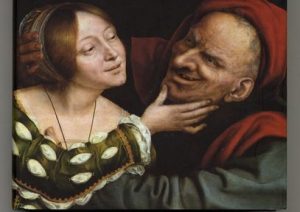On Ugliness (Umberto Eco, 2007)

The Truth of Ugliness
Last night before sleep I looked at some photos—pictures of beauty and ugliness—that had been gathered on a web news site. There were collections of moments of victory at the winter Olympics, and another of drops of water freezing into snowflakes magnified so we could glimpse the delicate prisms of crystals as they formed. Then I clicked on a collection of shots from the protests that have beset Independence Square in Kiev in recent days. The sight of the violence and bloodshed was heart rending: lifeless bodies laid out on tarps, police officers beating and being beaten, inadequate emergency triage centers helping the wounded, protesters with clothing in flames as they attempted to keep government forces out of the square by lighting their barricades on fire. The eyes of Olympians alive with excitement, the eyes of Ukrainians wracked with pain, anger, and fear. Another set of photos was a tour of the “Museum of Corruption,” the ostentatiously opulent palace ousted Ukrainian President Yanukovych had built for himself while the country’s economy languished. In these the beauty of art, craftsmanship and exquisite materials was twisted into an ugly display of arrogant greed. Beauty and ugliness are everywhere in our broken world, if we have eyes to see, and it can be debated which one takes precedence.
Novelist Umberto Eco points out that it’s not quite accurate to assume ugliness is simply the opposite of beauty. He notes that “all the synonyms for beautiful could be conceived as a reaction of disinterested appreciation”—terms like harmonious, sublime, pretty, delightful. In contrast he notes, “almost all the synonyms for ugly contain a reaction of disgust, if not of violent repulsion, horror, or fear”—terms like abominable, revolting, indecent, displeasing. (p. 16). The idea of beauty lends itself to quiet reflection, while ugliness evokes a deep, visceral reaction. Just as standards for beauty are not identical across cultures and time, so it is with definitions of ugliness. And to complicate things further, there is in the West a long tradition of belief that “any form of ugliness can be redeemed by a faithful and efficacious artistic portrayal” (p. 19). A good artist can make a lovely painting of a heap of rotting, repugnant trash.
In On Ugliness, Eco stimulates us to think through the meaning and depiction of ugliness in a lusciously illustrated book that covers 2500 years of Western art and literature. Eco separates the various depictions of ugliness over this span of history in a variety of helpful categories: the obscene, witchcraft, the apocalyptic, comic, industrial, kitsch, decadence, and more. Naming the manifestations of ugliness in this way allows the role, meaning and effect of ugliness to take on sharper relief. On Ugliness also showed me the importance of understanding ugliness if we want to be discerning about beauty. Not because beauty cannot be embraced and enjoyed before first gazing on ugliness, but because isolating ourselves from ugliness can cause us to mistake sentimentality for beauty. On Ugliness also reminds me that although beauty attracts us because we are made for it, courage is required to intentionally face ugliness. It is because there is such a reactive element in recognizing ugliness that we need to be certain we can face it in our broken world without merely being reactionary. After all, as the sets of photos I looked at demonstrate, ugliness smears much of life in a fallen world.
I wouldn’t put Eco’s book on the bedside stand in your guestroom. And I shouldn’t have to mention that you will find some of the illustrations and excerpts included in the book to be revolting. It is, after all, On Ugliness.

